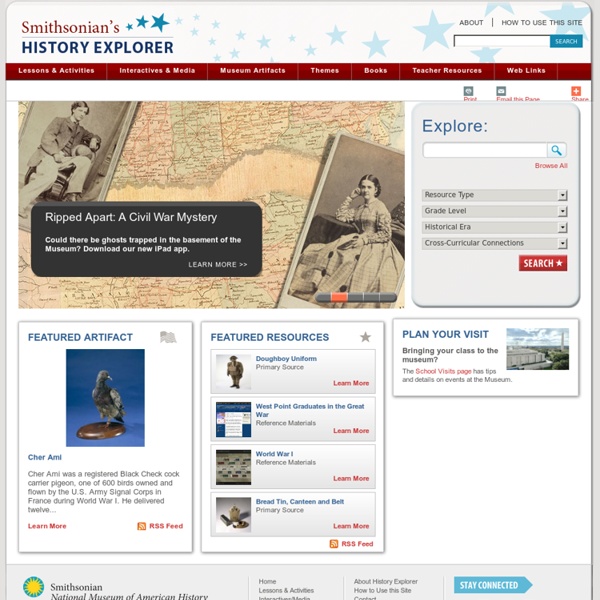



http://historyexplorer.si.edu/home/
Related: Visual Literacy in the Classroom • SOCIAL STUDIES - American HistoryTeaching History Resources - Historic Newspapers Looking after the world’s largest private archive of original newspapers means that we’re extremely passionate about history. This is why we decided to pick out interesting coverage from historical dates of significance so that others could learn about the past, as it was reported at the time! Our free teaching packs are available in order to help students discover the cause and consequence of historical events. Making of America aking of America (MoA) is a digital library of primary sources in American social history from the antebellum period through reconstruction. The collection is particularly strong in the subject areas of education, psychology, American history, sociology, religion, and science and technology. The collection currently contains approximately 10,000 books and 50,000 journal articles with 19th century imprints.
Primary Source Materials What is a Primary Source? When teaching and learning history, the term "primary source" generally refers to official documents, letters, diaries, photographs, advertisements and about any other print material found in its original form. These materials may be transcribed and/or reproduced. However, for purposes of historical accuracy the content will reflect the original document. Teacher Resources The Library of Congress offers classroom materials and professional development to help teachers effectively use primary sources from the Library's vast digital collections in their teaching. Find Library of Congress lesson plans and more that meet Common Core standards, state content standards, and the standards of national organizations. Discover and discuss ways to bring the power of Library of Congress primary sources into the classroom. Go to the blog Subscribe to the blog via e-mail or RSS.
Island of Hope - Island of Tears : National Park Service <div style="padding:5px; font-size:80%; width:300px; background-color:white; margin-left:auto; margin-right:auto; border:1px dashed gray;"> Internet Archive's<!--'--> in-browser video player requires JavaScript to be enabled. It appears your browser does not have it turned on. Please see your browser settings for this feature. Teaching Visual Literacy to Students Visual literacy is a multi-faceted subject matter, and faculty wishing to include images in their curriculum can quickly find themselves overwhelmed by the prospect of addressing visual literacy. For an introduction to the topic visit The Basics of Visual Literacy: Form, Context and Content. The following tools are intended to help faculty customize their curricula to incorporate visual literacy in ways that suit their individual instructional needs. Some faculty may want to teach visual literacy as a one-time in- or out-of-class activity.
a Program of the National Park Service NEW! Arthurdale: A New Deal Community Experiment Explore Arthurdale, West Virginia, and discover a town founded during the Great Depression when First Lady Eleanor Roosevelt championed subsistence homestead communities for struggling Americans across the country. In this lesson, learn about the impoverished Appalachian mining town that Arthurdale's homesteaders left and the Progressive-era theories about communal work, school, and rural life they tested at their new home. Meet 21st Century State Standards with TwHP Teaching with Historic Places lesson plans, based on the inquiry method, provide teachers with materials and question sets that encourage analytical thinking. This makes them a great choice for classrooms where students need to meet Common Core state standards and social studies standards based on the College, Career & Civic Life Framework.
December 5 Henry Reed Henry Reed Henry Reed was the narrow neck in the hourglass of tradition, through which tunes were guided back out into the wider currents of circulation. Alan Jabbour Josh and Henry Reed, circa 1903. Activities - Xpeditions @ nationalgeographic.com Your Mission Crack the code to find out where the thieves are taking the loot. Briefing Crafty robbers broke into the Royal Geographical Society in London and stole armfuls of priceless maps. Finding them would be hopeless, except that they dropped a scrap of paper with some odd scribbles on it. At the top is a rhyme that seems to be an instruction from the thieves' boss:
A Pictures Worth A Picture’s Worth Analyzing Historical Photographs in the Elementary Grades Keith C. Barton A picture can be worth a thousand words—and maybe a lot more.